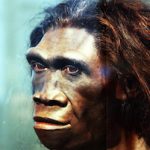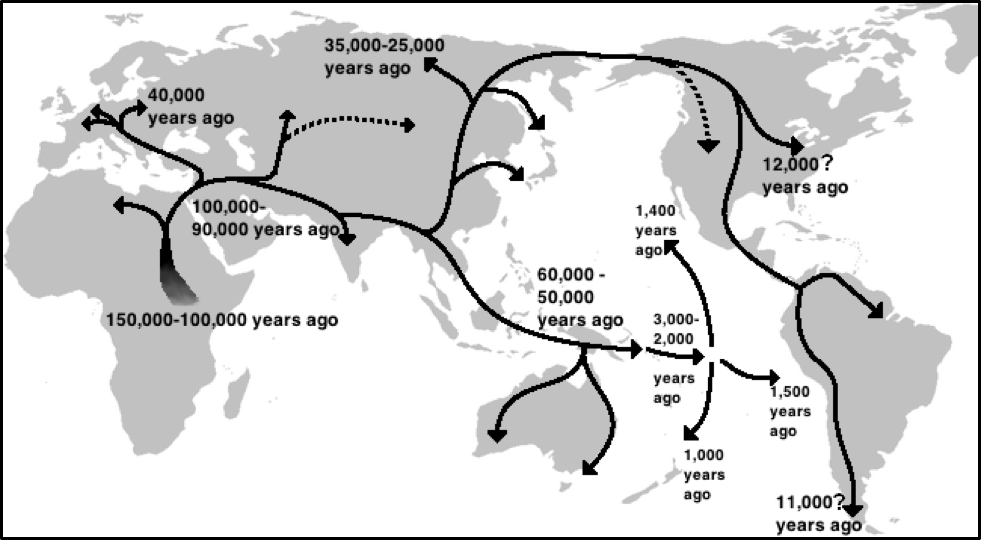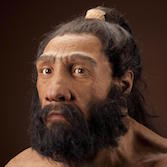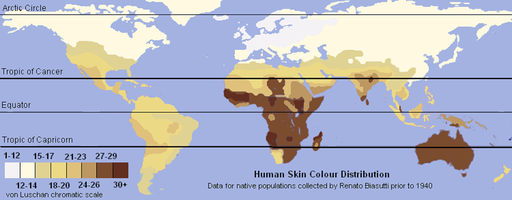2 The Human Family
Nolan Weil
Suggested Focus
There are several important arguments in this chapter. If you follow them carefully, you may come away with all the necessary resources to address the following questions and tasks.
- What does it mean to say that human diversity is geographically structured?
- Explain the essential difference between the Multiregional Origin Hypothesis and the Recent African Origin Hypothesis. How does your previous understanding of human origins compare with these explanations?
- List at least three genetically determined traits discussed in the chapter. Which two seem linked to geography and climate? Which one might be due mainly to chance?
- Explain the connection between geography, human nutritional requirements, and skin color.
- How has the concept of race changed since the time of Carl Linnaeus?
Origins and Diversity of Humanity
In the chapter after this one, we will trace human culture back to its earliest origins and then linger for a while in the Upper Paleolithic, which lasted from about 50,000 to 10,000 years ago. But in this chapter, we will set the stage for that story by looking at the origins and diversity of Homo sapiens, which is the scientific name of our species.
Although we humans are not the only species to exhibit culture, we depend on it in a way that no other species does. Moreover, human culture is certainly as old as the human species itself. But how old is that? And how do we explain human diversity? Finally, how did our species come to be distributed across the whole earth?
Anyone who has ever visited an ethnically diverse city like New York, London, Toronto, or Sydney, is surely impressed by the diversity of people living in these cities. These cities, and others like them, have attracted migrants from every corner of the world. Noticing this diversity may naturally make some of us curious. Where is this or that person from? Or to be more precise, where are the person’s ancestors from (for the person in question may be truly from New York, having been born there and having never lived anywhere else). Sometimes it is hard to guess from a person’s appearance where his/her ancestors are from originally. But sometimes it is not so hard. Where do you suppose the ancestors of the people depicted below probably originated?




Indeed, a person’s physical appearance can be a good clue from where in the world the person’s ancestors came. We see a person with a particular face, and we think — India, while for others, we think — China, or Africa, or Europe. Sometimes we can be even more precise—that person looks Somali, we think (if we are familiar with Somalis), while another we guess is an Eastern European of some sort. Of course, we can be mistaken, but those of us who have met people from many different places may become quite good at guessing a person’s ancestral origins. On the other hand, many people in the world today have mixed ancestry, which complicates the point I am trying to make. You may be wondering, “just what is that point?”
Only that humans exhibit a lot of genetic diversity (for it is our genes that determine our physical characteristics) and also that genetic diversity is geographically structured, which is the geneticist’s way of saying that people from particular regions resemble each other more than they resemble people from other regions. In the past, this observation led both laymen and scholars to believe that people could be neatly classified into easily distinguishable groups, called ‘races.’
Today, most biologists believe that (biologically speaking) the only race is the human race. What does this mean? Where did our respective ancestors come from in the first place? Did our ancestral groups just spring into existence independent of all other groups? Or is each group a branch from the trunk of one great tree, which came from a single seed? In other words, if we trace our ancestry back far enough, will we discover that we really belong, not to different regional tribes, but to one original tribe?
The academic discipline most intimately connected with the search for answers to questions about human origins is physical anthropology (also known as biological anthropology). We thus begin our cross-cultural explorations by first situating ourselves as a species.
Where did we all come from?

Scientific knowledge of human origins is based on the study of skulls and other skeletal remains, many of which were unearthed in the 20th century. In the last 30 years, advances in molecular genetics have also advanced our knowledge. Based on this material, many anthropologists have concluded that our first fully human (but not quite modern) ancestors appeared in Africa about 2 million years ago. We know them as Homo erectus (“upright man”). We call ourselves Homo sapiens (“wise man”), meaning that while we might see these distant cousins as somehow human, we do not see them as belonging to our species. But their exact relationship to us has been a subject of controversy over the last half-century, as scholars have debated two competing theories for explaining how human beings populated the planet. Let’s look at these two theories.
The Multiregional Origin Hypothesis
There are many variations of the Multiregional Origin Hypothesis, making it hard to construct a simple narrative, but the basic story goes something like this.
As suggested above, Homo erectus, first appeared in Africa about 2 million years ago. From fossil evidence, we guess that some groups migrated out of Africa reaching Indonesia, China, and Georgia about 1.7 million years ago. Other groups may have wandered into Europe about 1.5 million years ago. According to multi-regionalists, (e.g., Thorne & Wolpoff, 2003), as Homo erectus spread across Asia and Europe, they established separate regional populations. These populations gradually evolved with some gene mixing occurring when migrating groups sometimes came into contact with one another. Multi-regionalists propose that Homo erectus gradually evolved to eventually become Homo sapiens. If this theory is correct, say the multi-regionalists, it explains why Homo sapiens appeared suddenly across Europe, Asia and Australia about 50,000 years ago.
The Recent African Origin Hypothesis
Not every anthropologist accepts the Multiregional Origin Hypothesis. Supporters of the Recent African Origin Hypothesis agree that various species of the genus Homo, including Homo erectus first appeared in Africa and that some groups migrated out of Africa. They doubt, however, that Asian populations of Homo erectus gave rise to Homo sapiens. Instead, they argue, there were many migrations of various archaic humans out of Africa over 1.5-2.0 million years, none of which gave rise to Homo sapiens. According to the Recent African Origin Hypothesis, our immediate ancestors evolved—perhaps from Homo erectus, yes, although not of the world travelling Asian variety, but instead from those Homo erectus who had remained, evolving, in Africa (Cann & Wilson, 2003).
According to the Recent African Origin Hypothesis, our closest ancestors originated in East Africa about 150,000 – 200,000 years ago and migrated out of Africa in several waves beginning about 100,000 years ago. Some of these waves may have died out. But one wave, which began about 90,000 years ago, carried early humans out of Africa, possibly through present day Yemen. Over the next 15,000 years, groups of early moderns followed the coast of the Indian Ocean, around the Indian subcontinent as far as present day Indonesia and southern China. By about 65,000 years ago, some groups reached Australia, Borneo and New Guinea. About 50,000 years ago, after the climate in Europe began to warm following an Ice Age, some groups moved north and east across the European continent (Oppenheimer, 2003).


On these migrations, Homo sapiens may have encountered various hominid cousins, including Homo neanderthalensis (Neanderthal man). Some geneticists believe modern humans may carry a small amount (~2.5%) of Neanderthal DNA (Green, et al., 2010). Otherwise there is not much evidence of interbreeding between moderns and archaic humans. Eventually, all representatives of the genus Homo other than Homo sapiens disappeared; we do not know exactly why.
About 40,000-45,000 years ago, modern humans began spreading north throughout Asia. Then beginning about 25,000 years ago, some groups crossed over a Bering land bridge from Siberia to Alaska. Gradually, over the next 10,000 years, these migrants from Asia spread throughout all of North and South America. Of course, not everyone left Africa. Some descendants of groups that left may have even returned. We do not know all of the details, but over the past 30 years, a lot of evidence has been discovered that supports the Recent African Origin hypothesis (Oppenheimer, 2003). Today, it is probably fair to say, it is the consensus view among anthropologists although few would say the matter is completely settled.
If the Recent African Origin theory is correct, it means every living human being can trace his/her ancestry to Africans who left Africa roughly 90,000 years ago. In other words, there is a fundamental sense in which deep down we are all African, and ultimately as different as we may seem to be, we are all one big family.
But why do we all look so different on the surface?
If our ancestors all came from Africa, you may be wondering, why do we all look as different as we do? To answer this question, we have to draw on principles from evolutionary biology and population genetics.
To survive, a species must be well adapted to its environment. Some species occupy a very narrow geographic range; we say it is specialized. For example, the koala lives only in Australia and eats primarily the leaves of eucalyptus trees. Koalas do not exhibit much variation and cannot live in very many places. Other species, however, are generalized; they inhabit a wide range of environments and exhibit a greater degree of variation. We humans are an example of a generalized species. We inhabit environments from the tropics to the arctic, from deserts to rainforests, and from sea level to high mountains. Many of the traits we possess are what biologists call polymorphic, that is they exist in many different forms, which allow us to adapt to a wider range of environments (Feder and Park, 1993: p. 328).
One trait that shows great variation in humans is skin color. If we look at a map showing the distribution of skin color across the world today, we find that darker skin is concentrated near the equator while lighter skin is concentrated in the northern latitudes. If the recent African origin theory is correct, our earliest modern human ancestors evolved in Africa for about 100,000 years before leaving on their journeys to the far ends of the earth. Those ancient ancestors were most certainly black, having evolved in the intense equatorial sun.

Black skin provides some protection against sunburn and skin cancer. That much is true. But this is probably not the reason our African ancestors evolved dark skin.
More important may have been a connection between skin color, ultraviolet radiation (UV), and an important vitamin. According to Jablonski & Chaplin (2010), dark skin is the body’s way of preserving folate (Vitamin B), which is rapidly destroyed by UV radiation leading to folate deficiency, a major cause of birth defects, developmental disorders, and various degenerative diseases (Lucock et al., 2003). Light skinned people would not have thrived in such an environment; therefore, the frequency of genes for light skin would have been greatly reduced or eliminated from the gene pool.
When the earliest migrations out of Africa took humans around the coast of India, the selective pressures (with regard to skin color) remained the same. Indeed, people indigenous to southern India tend to be quite dark. But as human populations moved northward, selective pressure for dark skin diminished. In fact, populations in the northern most latitudes encountered a different kind of adaptive challenge. Adequate Vitamin D synthesis requires exposure to UV radiation. Humans in the northern latitudes needed to absorb all the UV light they could for Vitamin D synthesis. Since white skin allows in more UV while dark skin filters it out, populations that settled in the north underwent selection for white skin. Dark skinned people in the far north would have suffered from rickets, a bone disease caused by Vitamin D deficiency. The fact that some northern people (like the Inuit) are darker than we would expect is explained by their diet of fish and marine mammals, which is rich in Vitamin D. Because the Inuit got adequate Vitamin D from their food, they did not depend on sunlight for Vitamin D synthesis and so did not face selective pressure for lighter skin.
Populations that settled in the middle latitudes (between 23° and 46°) evolved yet another adaptive trait. In the middle latitudes, UV radiation varies greatly by season, so people indigenous to the middle latitudes evolved white skin with the ability to tan (i.e., become darker). In essence, they could change their color considerably, becoming several shades darker in summer, and getting pale again with the winter. In the modern era, of course, people of all colors have migrated, or been otherwise displaced, to places not originally inhabited by their ancestors. Cultural adaptations compensate for any environmental disadvantages associated with particular skin colors. For instance, white people in sun-drenched regions shield themselves from UV radiation with clothing, and black children in sun-deprived regions may drink milk, which in places like the U.S. is routinely fortified with Vitamin D.
Body build is another trait that may have undergone selection. People like the Maasai of Kenya, who live in a hot climate, are often long limbed and slender, which promotes heat loss. People like the Inuit (mentioned above), who live in a cold climate, are often stocky with short fingers and toes, a body build that helps preserve body heat. Similarly, people whose ancestors settled in cold or dry areas often have long noses to warm or moisten the air before taking it into the lungs. People whose ancestors stayed in hot humid places (where the air is already warm and moist) have noses that are short and broad.
So one explanation for human physical variation is natural selection, which is the idea that the environment (e.g., geography and climate) selected particular traits and not others. Why? Because those traits enabled the individuals that possessed them to reproduce more successfully and therefore to pass these genetically determined traits to their offspring. As our African ancestors settled in different regions over tens of thousands of years, they gradually acquired physical traits well suited to their environments. They began to look more and more like the people that today we would tag as Indian, and Chinese, and Northern European, and for that matter African too.
But while natural selection shapes the physical characteristics of populations, random processes also play a role. Gene flow and genetic drift are random processes that also surely affected our ancestors on their global migrations. For much of human history, humans lived in small, geographically separated groups of interbreeding individuals. Sometimes, different populations came into contact and interbred. When this occurred, there was gene flow, or the mixing of genes between two populations. Gene flow served to reduce the genetic variation between interbreeding groups. Physical differences between the groups became blurred as a result of mixing.
On the other hand, sometimes a population may have split into two or more groups, each of which went its own way. This led to genetic drift. Especially when populations are small, chances are that the frequencies of particular genes in populations that split will be quite different. For example, it is not likely that the (many) genes that control height will be equally distributed when a relatively small population splits into two groups. One group may retain more of the genes that contribute to a taller stature, and after several generations, the average height of one group will tend to be greater than that of another (Feder & Park, 1993).
In conclusion, nearly 100,000 years of migrations have shaped from an original population of Africans an assortment of regional groups differing phenotypically from each other in ways shaped by geography, climate, and chance. At the same time, Africans themselves have also continued to evolve. Today Africa remains the continent with the greatest amount of genetic (and linguistic) diversity anywhere on the earth, further lending support to the idea that it all started in Africa.
Race is not a biologically meaningful concept
The topic of race is a sensitive one because race is historically tied to issues of inequality and oppression that still trouble us today. But what is race? Simply stated, race involves the idea that humans can be classified into a few basic groups based on genetic and physical traits, ancestry, or social relations. Today scholars think of race as a folk concept, not a scientific concept although once upon a time, the concept was treated with great scientific authority.
It is true that most groups tend to classify other groups in relationship to themselves. A group with limited knowledge and experience of another group living nearby may merely create a simple category that distinguishes the in-group from the out-group. For instance, the Abenaki who inhabited the northern regions of North America, and referred to themselves as Alnôbak, “real people,” referred to their neighbors in the arctic as Eskimo, “eaters of raw flesh,” or so it is widely believed. Meanwhile, the ‘Eskimo’ called themselves Inuit, or … you guessed it, “real people.” Each group thought of itself as “real people,” while they thought of the other group as, well, perhaps not real people.
On the other hand, complex societies with considerable knowledge of other people may produce elaborate systems of classification. It is often said that Europeans had no particular awareness of race until the 1700s; however, a variety of cultural documents from the European Middle Ages show that during the 13th, 14th, and 15th centuries, Europeans were already creating a discourse of race even before the development of an explicit vocabulary of race (Heng, 2011).
Europeans had, of course, long been familiar with the peoples of Africa and the Middle East. But from the 15th-18th centuries, Europeans also began to encounter many of the world’s other peoples for the first time, especially in the Americas, Australia and the Pacific Islands. These encounters along with the rise of science set the stage for the development of scientific attempts to explain human diversity, and the concept of race became a subject of scientific interest.
Scientists such as the Swedish botanist, physician and zoologist, Carl Linnaeus, laid the foundation for a scientific racism that would last well into the 20th century. In 1735, Linnaeus invented a system for classifying living organisms that would greatly influence European ideas about race. Linnaeus classified humans into four racial types based on skin color and facial and bodily features. He named the types after their assumed place of origin, associating each type with a color: Africanus (black), Asiaticus (yellow), Americanus (red), and Europeaeaus (white). He even described behavioral traits he thought distinguished each race. While biologists still regard the Linnaean system as useful for classifying living organisms generally, modern biologists eventually rejected Linnaeus’ classification of humans by racial type (Jandt, 2016, pp. 9-10).
For centuries though, racial classification was considered scientifically legitimate. Moreover, Europeans’ embrace of scientific racism assured them of their own racial superiority. From the 16th to the mid-20th century, scientific racism made it easy for Europeans to justify their colonial domination and exploitation of indigenous populations in North and South America, Africa, the Middle East, South Asia, Australia and the Pacific Islands. The history of nations in the ‘New World,’ from the United States to Brazil, is still tarnished by the legacy of black slavery, justified by a theory of race reinforced by the science of the day. Unfortunately, even after slavery was finally ended, racist assumptions continued, casting a long shadow over the lives of the descendants of enslaved peoples.
In the mid to late 20th century, Western nations began the slow and painful work of confronting and redressing racial injustices of the past. Biologists, working with the benefit of advanced technologies, particularly in the field of genetics, began to realize that the centuries old theory of race was genetically incoherent. Today, the scientific consensus is that while human diversity is undeniable, traditional systems of racial classification have no biological basis (Feder & Park, 1993).
Nevertheless, it is difficult for many people to accept that when we think we see people of different races, we are deceived. To understand how this is so, we should realize that despite the visibility of a few (genetically determined) traits, humans vary (genetically) in many other ways that are not visible. And if we are going to find a genetic basis for race, we should look at all of our genes, not just the ones that result in a few visible traits. For a theory of race to have any genetic basis, geneticists should be able to find large groups of people that are genetically homogeneous within their group but heterogeneous with respect to contrasting groups. This is just not the case. A tremendous amount of genetic variability is actually shared among supposed racial groups, and genetic variation between individuals of the “same racial group” is sometimes greater than the genetic variation between individuals of two “different racial groups.” In other words, geneticists are not able to find any non-arbitrary way to draw boundaries around groups (Marks, 2010).
But surely, some people may still argue, the fact that one person’s skin is as black as mahogany while another’s is almost as white as snow is evidence of some typological difference. Indeed, skin color, in particular, continues to be a salient feature for many, even if they agree that skin color is just one trait among many. For any reader that is not persuaded by the arguments against the reality of race articulated above, Relethford (2009, p. 21) has suggested that comparing traits such as skin color to height might help us understand the problem better. Borrowing from Relethford’s argument, we might note, for instance, that like skin color, height too is a continuous variable. In other words, people come in all sizes from very short to very tall and everywhere in between just as people come in many different shades of color. In daily conversation, we may use crude labels such as ‘‘short,’’ ‘‘medium,’’ and ‘‘tall,’’ but do we think that these represent three precisely defined groups. In most places in the world, 198 cm would certainly be tall. But how about someone who is 218 cm. Suddenly, we might feel the need for a new category—“very tall.” And where exactly should we draw the line between tall and very tall: 207 cm, 208 cm, or 207.5 cm? And how many categories would we feel we needed to cover people of every height? Relethford’s point is that we know that the labels we use in everyday life are subjective and imprecise, but no one thinks that terms like ‘‘short,’’ ‘‘medium,’’ and ‘‘tall’’ refer to discrete groups, and that human beings comes in only three, or five, or seven varieties of height.
In the end, Relethford says:
Race is a crude first-order approximation to human biological variation that is arbitrary in terms of the number and definition of races. As such, race may not provide the best way of describing or analyzing human variation.
This does not contradict what we have said earlier, that human variability is geographically structured, and that based on a person’s appearance, we can often guess at the geographical origins of his/her ancestors. But that is not the same thing as saying that the person in question belongs to some genetically coherent category that one could call a race. In the end, there is only one race, the human race.
Final Reflection
Although socially constructed concepts of race do not appear to rest on firm biological foundations, race will no doubt continue to occupy a prominent place in the social and political discourse, especially in countries with colonial legacies or histories stained by slavery and racial injustice. And scientific or not, the social construction of race is often a basis for the formation of identity, although whether that identity can in every instance be legitimately called a cultural identity is another matter for debate.
Application
For Further Thought and Discussion
- Now that you have finished reading Chapter 2 what is your response? What was familiar to you? Did anything surprise you?
- How was the origin of humans explained in the community where you grew up? Was there more than one explanation?
- How much attention do people where you are from pay to skin color? Is skin color seen as a basis for differentiating people in any way? If so, how?
- What is the writer’s point of view on race? Do you find it persuasive? Why or why not?
For Further Reading
Human skin color. Wikipedia contributors, (2019, September 4). In Wikipedia, The Free Encyclopedia. Retrieved 18:39, September 5, 2019, from https://en.wikipedia.org/w/index.php?title=Human_skin_color&oldid=914032650
References
Cann, R. L. & Wilson, A. C. (2003). The recent African genesis of humans. Scientific American, 13, 54-61. doi:10.1038/scientificamerican0503-54sp
Feder, K. L. & Park, M. A. (1993). Human antiquity: An introduction to physical anthropology and archaeology, (2nd ed.). Mountain View, CA: Mayfield.
Green, R. E., Krause, J., Briggs, A. W., et al. (2010). A draft sequence of the Neanderthal genome. Science, 328(5979), 710-722. doi: 10.1126/science.1188021
Heng, G. (2011). The invention of race in the European Middle Ages I: Race studies, modernity, and the Middle Ages. Literature Compass 8(5), 315-331. https://onlinelibrary.wiley.com/doi/epdf/10.1111/j.1741-4113.2011.00790.x
Jablonski, N. G. & Chaplin, G. (2010). Human skin pigmentation as an adaptation to UV radiation. Proceedings of the National Academy of Sciences, 107 (Suppl. 2), 8962-8968. doi:10.1073/pnas.0914628107
Jandt, F. E. (2016). An introduction to intercultural communication: Identities in a global community, (8th ed.) Thousand Oaks, CA: SAGE Publications.
Lucock, M., Yates, Z., Glanville, T., Leeming, R., Simpson, N. & Daskalakis, I. (2003). A critical role for B-vitamin nutrition in human development and evolutionary biology. Nutrition Research, 23, 1463-1475.
Marks, J. (2010). Ten facts about human variation. In M. P. Muehlenbein (Ed.), Evolutionary Biology. New York: Cambridge p. 270.
Oppenheimer, S. (2003). The real Eve: Modern man’s journey out of Africa. New York, NY: Carroll & Graf.
Relethford, J. H. (2009). Race and global patterns of phenotypic variation. American Journal of Physical Anthropology, 139(1), 16–22. http://dx.doi.org/10.1002/ajpa.20900
Thorne, A. G. & Wolpoff, M. H. (2003). The multiregional evolution of humans. Scientific American, 13, 46-53. doi:10.1038/scientificamerican0492-76
Image Attributions
Image 1: “Chinese woman” by Aldousleung is licensed under Public Domain 1.0
Image 2: “Indian Man” is licensed under CC0 Public Domain
Image 3: “Somali Man” is licensed under CC0 1.0
Image 4: “Karolina Kurkova Shankbone 2009 Metropolitan Opera” by David Shankbone is licensed under CC BY 3.0
Image 5: “Homo erectus adult female – head model – Smithsonian Museum of Natural History” by Tim Evanson is licensed under CC BY-SA 2.0
Image 6: “Human Migration Out of Africa” by Ephert is licensed under CC BY-SA 3.0
Image 7: “Neanderthals, based on the skull from Shanidar 1, Iraq.” Artwork: John Gurche. Image credit: Human Origins Program. Copyright, Smithsonian Institution.
Image 8: “Unlabeled Renatto Luschan Skin color map” by Dark Tichondrias/Dark Tea is licensed under CC BY-SA 3.0

